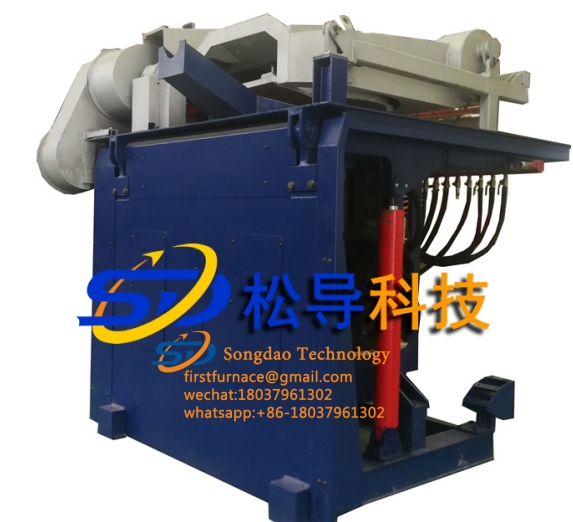- 31
- Mar
Koja je razlika između indukcijske peći srednje frekvencije i elektrolučne peći?
Koja je razlika između indukcijske peći srednje frekvencije i elektrolučne peći?
Iako su električne lučne peći i indukcijske peći srednje frekvencije obično korištena oprema za topljenje lijevanog čelika u tvornicama, indukcijske peći srednje frekvencije imaju sljedeće karakteristike u pogledu kapaciteta rafiniranja i prilagodljivosti u usporedbi s običnim električnim lučnim pećima.
1. Karakteristike u smislu sposobnosti rafiniranja
Električne lučne peći su bolje od indukcijskih peći u uklanjanju fosfora, sumpora i deoksidacijskom kapacitetu. Indukcijska peć je hladna šljaka, a temperatura šljake se održava toplinom koju daje rastopljeni čelik. Električna lučna peć je vruća šljaka, a šljaka se zagrijava električnim lukom. Defosforizacija i odsumporavanje se mogu završiti kroz šljaku, a šljaka je potpuno difuzna i deoksidirana. Stoga je sposobnost elektrolučne peći da ukloni fosfor, sumpor i kisik bolja od indukcijske peći. Sadržaj dušika u čeliku za topljenje u elektrolučnim pećima je veći nego u indukcijskim pećima. To je zato što se molekule dušika u zraku u visokotemperaturnoj zoni luka joniziraju u atome, a zatim apsorbiraju rastopljeni čelik. Legura za topljenje u indukcijskoj peći ima niži sadržaj dušika od elektrolučne peći i veći sadržaj kisika od elektrolučne peći, a legura ima veću vrijednost brzog vijeka trajanja od elektrolučne peći.
2. Visoka stopa oporavka elemenata od istopljene legure
The yield of alloy elements smelted by induction furnace is higher than that of electric arc furnace. The volatilization and oxidation loss of elements are large under the high temperature of the arc. The burning loss rate of alloying elements in induction furnace smelting is lower than that of electric arc furnace. In particular, the burning loss rate of the alloy elements in the return material loaded with the furnace is much higher than that of the induction furnace. In the induction furnace smelting, it can effectively recover the alloying elements in the return material. During electric arc furnace smelting, the alloying elements in the return material are first oxidized into the slag, and then reduced from the slag to the molten steel, and the burning loss rate is significantly increased.
Prilikom vraćanja materijala u topljenje, stopa povrata legure u indukcijskoj peći je znatno veća od one u električnoj lučnoj peći.
3. Nisko povećanje ugljika u rastopljenom čeliku tokom topljenja
Indukcijska peć se oslanja na princip indukcijskog grijanja kako bi se rastopio metalni naboj bez povećanja ugljika u rastopljenom čeliku. Električna lučna peć se oslanja na grafitne elektrode za zagrijavanje naboja kroz električni luk. Nakon topljenja, rastopljeni čelik će povećati ugljik. U normalnim uslovima, pri taljenju visokolegiranog nikl-hrom čelika, minimalni sadržaj ugljika kod taljenja u elektrolučnim pećima iznosi 0.06%, a kod topljenja u indukcijskoj peći može doseći 0.020%. Povećanje ugljika u procesu topljenja u elektrolučnoj peći je 0.020%, a u indukcijskoj peći 0.010%. Indukcijska peć srednje frekvencije bez vakuuma je pogodna za topljenje niskougljičnih i visokolegiranih čelika i legura.
4. Electromagnetic stirring of molten steel improves the thermodynamic and dynamic conditions of the steelmaking process The movement conditions of molten steel in the induction furnace are better than those of the electric arc furnace. The electric arc furnace must be equipped with a low-frequency electromagnetic stirrer for this purpose, and its effect is still not as good as that of an induction furnace. The electromagnetic stirring effect in the induction furnace improves the reaction kinetic conditions and promotes the homogenization of the temperature and composition of the molten steel. However, excessive stirring will not be conducive to the removal of inclusions and damage the furnace lining.
5. The process parameters of the smelting process are easy to control. The control of temperature, refining time, stirring intensity and constant temperature during induction furnace smelting are all more convenient than electric arc furnaces and can be carried out at any time. Because the induction furnace has the above characteristics, it is a relatively important position for comrades in the smelting of high alloy steels and alloys. It can produce products independently, and can also be combined with secondary refining such as electroslag remelting and vacuum self-consumption to form a dual process for production. Therefore, non-vacuum intermediate frequency induction furnace smelting has become an important smelting method for the production of special steels and alloys such as high-speed steel, heat-resistant steel, stainless steel, electrothermal alloys, precision alloys, and high-temperature alloys, and has been widely used.

